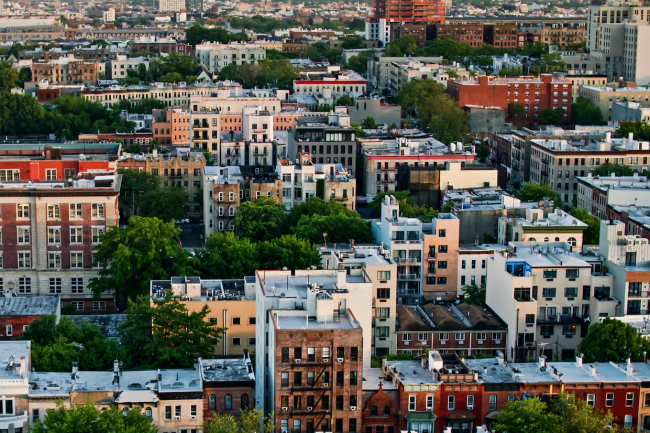Planning a move in 2022? Covid shook up NYC's rental market. Here's what you need to know

Even if you're a experienced renter in NYC or somewhere else, a lot has changed about renting here as a result of the pandemic.
iStock
Maybe one of your new year’s resolutions is to upgrade to a larger New York City rental or you're considering a move to the city for the first time. Even if you're a experienced renter in NYC or somewhere else, a lot has changed about renting here as a result of the pandemic and it's a good idea to brush up on some market intel to avoid sticker shock and a frustrating search.
Over the past year the city's rents have gone from low (by New York standards) back to nearly pre-pandemic levels. It's more difficult to find a place to rent at the moment because there are fewer listings and deals are harder to come by. Looking ahead, it's possible the number of vacant apartments will increase because landlords are expected to send out renewal notices with rent increases that some renters won't be able to afford.
To give you the best chance of finding a place, here's what you need to know ahead of your search.
Rents are increasing
Rents are going up. They aren't yet at 2019 rates but they aren't far off. If you're looking for a high-end apartment—a building with a doorman and other amenities—you'll find this is where rents are increasing fastest. Larger apartments with more space are in demand from New Yorkers who are working from home.
The good news is the mad rush to get back to the city, which happened in the middle to latter half of last year, has largely passed and the winter months are typically quieter so if you can find what you want, you may even get a deal on a rental. If you find what you're looking for before the spring, you may want to consider asking for a longer lease to lock in the rent. For more tips, check out: "8 mistakes to avoid if you’re a first-time NYC renter."
Listings are slim
Because fewer people move in the winter (and the pandemic still has a tight grip on the city) there are fewer listings at this time of year. It's possible landlords might even hold back apartments for a few more months so they can lease them out at higher rents in the spring.
Fewer listings drives up competition but there are a few strategies to help you find a place. For example you can identify the building you want to live in and reach out directly to the management company of some of the larger buildings. If you are flexible on the layout or floor you want, some buildings may have more availability than appears online. For more, read: "7 tips for finding a NYC rental when there's lots of competition for apartments."
Need help renting the perfect apartment in the perfect neighborhood? Looking for a landlord who is flexible about guarantors, pets, or "flexing" a space with temporary walls? Put your search into the capable hands of Triplemint, a tech-savvy real estate brokerage founded by a pair of Yale grads in response to the frustrating apartment-search experiences of classmates and colleagues. Triplemint will charge a broker's fee of 10 percent of a year's rent on open listings instead of the usual 12 to 15 percent if you sign up here. Bonus: The agents at Triplemint are a delight to deal with.
Bidding wars may return
Bidding wars are common in a competitive sales market, but last year many renters were stunned to find themselves in bidding wars for rentals. The demand in some parts of the city—like Tribeca, Soho, Greenwich Village, and parts of Brooklyn—was so intense, landlords were requesting best and final offers from renters. It may have been a localized phenomenon but it's a pattern that could be repeated if offices put off fully reopening until the summer when Covid cases are low and demand for apartments ramps up again.
The advice in these scenarios is to have your paperwork ready to go—tax returns, references, letters of employment—so you can put in an application on the spot and signal that you are easy to work with. Of course, offering to pay the broker fee if you aren't already, might also move the needle in your favor. For more advice, read: "Bidding wars for rentals: Returning NYers face intense competition for apartments."
Freebies are nearly gone
With landlords no longer desperate to fill empty apartments (as they were at this time last year) the generous concessions of 2021 are a thing of the past. If you're flexible about where you will live, the size of your apartment, and the amenities you want, you'll be in the strongest position to score a deal. For more, read: "How to move to NYC: A crash course to finding an apartment."
If your job has gone partially or fully remote and your commute isn't as time consuming during the week—you may have the ability to move to a more affordable neighborhood. Inwood in Manhattan, Richmond Hill in Queens, and Mapleton in Brooklyn are some of the most affordable neighborhoods according to data compiled exclusively for Brick Underground. For more, read: "Looking for a cheap apartment? Here are NYC’s most affordable neighborhoods for renters."
Need space to WFH? Consider the outer boroughs
Working from home has certainly changed how and where New Yorkers live: Without the need to commute, some are moving farther from their jobs to save money and trade up apartments to increase their living space.
It explains the increased interest in parts of the city that are less well served by the subway, for example, Red Hook. The Brooklyn neighborhood ranked fourth on a list compiled by StreetEasy of areas to watch in the coming months. For more, check out: "The NYC neighborhoods to watch in 2022."
You'll pay even more for outdoor space
Apartments with outdoor space have been selling at a premium during the pandemic and the same trends are evident in the rental market. If you want a place with a balcony or shared courtyard, you'll be asked to pay a higher rent in return.
Be warned, however, it's not all lounge chairs and happy hours. For some cautionary balcony tales, read: "10 things to consider before living in a NYC apartment with a balcony."
Pet policies have changed
A lot of buildings relaxed their pet policies to attract or retain renters and buyers during the pandemic. However, there’s a difference between a pet-tolerant and pet-friendly apartment buildings. Some buildings require pet owners to use the side entrances and not enter the lobby if they are with their dogs.
Specific language about pets is always in the lease or a rider to the lease, but it’s best to find out as much as you can about the pet policy ahead of time. For more on this, read: "When a pet friendly building isn’t friendly at all."
You Might Also Like



























